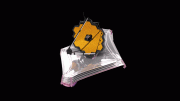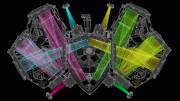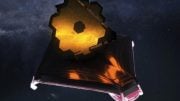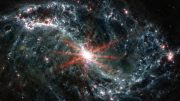
The beam of light coming from the telescope is then shown in deep blue entering the instrument through the pick-off mirror located at the top of the instrument and acting like a periscope.
Then, a series of mirrors redirect the light toward the bottom of the instruments where a set of 4 spectroscopic modules are located. Once there, the beam of light is divided by optical elements called dichroics in 4 beams corresponding to different parts of the mid-infrared region. Each beam enters its own integral field unit; these components split and reformat the light from the whole field of view, ready to be dispersed into spectra. This requires the light to be folded, bounced and split many times, making this probably one of Webb’s most complex light paths.
To finish this amazing voyage, the light of each beam is dispersed by gratings, creating spectra that then projects on 2 MIRI detectors (2 beams per detector). An amazing feat of engineering! Credit: ESA/ATG medialab
A discrepancy was found in the James Webb Space Telescope’s MIRI Medium Resolution Spectroscopy mode, with reduced throughput at the longest wavelengths. NASA and partners are investigating the issue and exploring mitigation strategies, while continuing MIRI observations.
All 17 observing modes of the James Webb Space Telescope undergo routine performance monitoring and calibration. This month, while performing calibration by comparing the brightness of standard stars that have been well-cataloged by other observatories to what Webb’s Mid-Infrared Instrument (MIRI) was receiving, team members noticed a discrepancy in the data.
Further analysis of MIRI’s Medium Resolution Spectroscopy (MRS) mode revealed that at the longest wavelengths, the throughput, or the amount of light that is ultimately registered by MIRI’s sensors, has decreased since commissioning last year. No effect has been seen for MIRI imaging, and there is no risk to the instrument. All other observation modes – within MIRI and each of Webb’s other scientific instruments – remain unaffected.
NASA and its partners are developing a systematic plan to approach, analyze, and then explore the issue. The Webb team will continue MIRI observations as planned. The team will gather all relevant ground test and flight data to fully assess MRS performance. Further test observations will be taken to completely characterize the nature of the issue using this particular mode of observation. Next, a plan for long term-monitoring will be enacted, while the team continues to investigate the cause, identify risks, and explore mitigations that would potentially improve performance. One possible mitigation strategy includes taking slightly longer exposures at the affected wavelengths to increase the signal-to-noise.






JWST would be used as AI to trace aliens on other habitable planets and its moons, while objects like alien spacecrafts or birds flying in the sky of its mother planet in our galaxy or other galaxies in the universe.
There is no artificial intelligence (AI) directly tied into the Webb. While it is used to assess a few planetary atmospheres for such things as astrobiology research its capabilities are considered to weak to observer sufficiently many such planets to find anything (but you never know beforehand).
No biologist is expecting to find a human – language capable – analog elsewhere, such evolutionary traits are too rare. But even if they were, I don’t see the relevance to the MIRI problem.